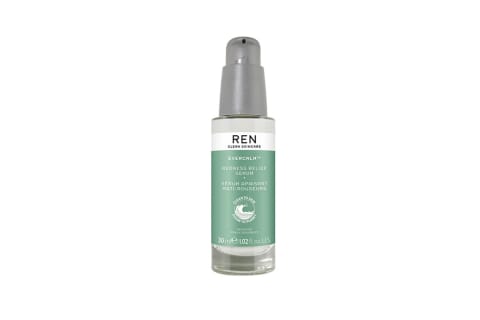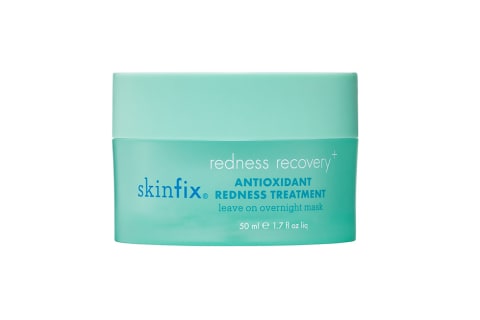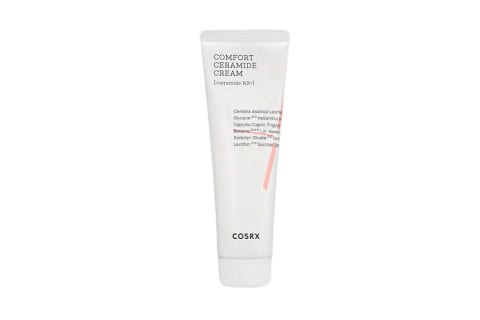How To Get Rid Of Redness On Face + Causes, From Derms

Skin redness is one of the most frustrating concerns to deal with. Not only does it get easily triggered by certain ingredients and treatments, but the root cause of redness isn’t often clear.
We know explaining the causes and best treatments for redness is a big feat, but we’re stepping up to the plate. Below, an in-depth guide for easing skin redness from board-certified dermatologists.
Facial redness causes
As mentioned above, facial redness can be caused by a plethora of factors. Oftentimes, it’s more than one. Below, a brief overview of the most common causes.

- Acne: Many kinds of acne show up as red, inflamed pimples. But it can also be accompanied by an overall redness too. “Redness from acne is an indication that there is an underlying irritation or inflammation in your skin. This is typically attributed to a hormone related imbalance,” says board-certified dermatologist, Associate Professor of Dermatology at Mount Sinai, and Advisor to Veracity Angela Lamb, M.D.
- Rosacea: This inflammatory skin condition often shows up on the cheeks and may look patchy. Many folks with rosacea will get “flare ups” when their skin is triggered be it by sun exposure, harsh topical ingredients, warm climates, or certain foods and drinks.
- Sunburn: When you’ve spent a bit too much time in the sun without SPF, you may get a facial sunburn. The reason your skin gets so red is because the blood flow is rushing to the surface in an effort to heal the skin barrier quickly.
- Dryness: “Redness as a result of dry skin may be an indication of an underlying issue such as dermatitis or eczema,” says Lamb. “In other cases, this could be a result of dehydrated skin, sometimes caused by a change in weather or a hormonal imbalance,” she adds.
- Exfoliation: “Irritation, redness, and inflamed skin are also all signs of over-exfoliation,” says board-certified dermatologist and head of the medical advisory board at Geologie Steve Xu, M.D., FAAD.
- Dermatitis: “Redness in the skin as caused by dermatitis is typically a result of an irritant or allergen,” says Lamb. This could be from a new skin care product you tried or environmental irritants.
- Stress: “Often stress can trigger an external response in our bodies resulting in the form of a rash,” says Lamb.
- Diet: “If you notice redness in your skin as a result of food, you are more likely allergic to something in your diet. Other reasons for skin inflammation from diet include foods that are known vascular dilators (spicy or acidic foods) as well as hot foods,” says Lamb. You may also experience heightened oil production during times of stress resulting in stress acne.
- Nutrient deficiencies: “On the other hand, this could also be an indication that your diet lacks the necessary vitamins and minerals to produce healthy, glowing skin,” says Lamb. To find out if you’re experiencing nutrient deficiency, visit a medical professional.
- Hormonal imbalances: “Redness in the skin can often be a result of a hormonal imbalance. Decreased estrogen levels can cause the skin to become itchy, sensitive, or irritated,” says Lamb. You may also experience hormonal acne along the jawline, sides of the cheeks, and chin as a result of imbalance.
How to get rid of redness on face at home
If you can pinpoint exactly what’s causing your facial redness (or visit a dermatologist for help) that’s the best first step. Either way, adding soothing topical products and healthy lifestyle practices will help to ease the flushing. Below, a few trusted methods.
Colloidal oatmeal and oat extracts
“Colloidal oatmeal has been used for a variety of skin conditions in the past,” says Xu. "It has been shown to have antioxidant, anti-inflammatory, and antimicrobial properties, but its most effective use is reducing itching and repairing the skin barrier.”
He adds, “those that have dealt with eczema, for example, have found relief from products that use colloidal oatmeal.” However, the healing properties of colloidal oatmeal and oat extract can help anyone ease redness and irritation. Plus, it’s safe for sensitive skin types.
However, Lamb notes that colloidal oatmeal isn’t the best ingredient for those with celiac disease as it can cause an allergic reaction.
Ease acne
“If your redness is being caused by an inflammatory skin condition like acne, using targeted treatment to get your acne under control will help to fight redness,” says board certified dermatologist, Chief Medical Officer and Co-Founder of Fig.1, Courtney Rubin, M.D., FAAD.
Acne is a highly complex skin condition with many compounding factors including genetics, skin type, hormone levels, and more. Classic acne-easing ingredients like salicylic acid and retinol will be helpful for many, but each person is different.
If you’re looking to clear up breakouts, start here with our full guide to the many different types of acne. For those who have yet to find a successful treatment or those with cystic acne, visit a dermatologist for a customized treatment plan.
Take a break from exfoliating
“A break from exfoliation can also help heal irritated skin,” says Xu. This applies to both physical and chemical exfoliants. Set down the scrubs and AHA or BHA treatments for a few days to allow your skin to heal before continuing your normal regimen.
Over-exfoliation can be caused by using a treatment that’s too strong for your skin type, or using an exfoliant too often. Most people don’t need to be exfoliating daily, so try to space out this step to a few times a week at most.
During your break from exfoliants, spoil your skin with hydrating serums and moisturizers—more on that next.
Hydrate
“Implement a gentle, skin barrier supportive skincare routine,” Rubin says. This may include a gentle cleanser (read: no scrubs or enzyme cleansers for now), a hydrating serum, a nourishing moisturizer, and even a face oil to seal in the hydration.
Rubin's pick: Fig. 1 Ceramide Moisturizer because it's loaded with ceramides, hyaluronic acid, squalene, and peptides to support the skin barrier and prevent moisture loss.
When shopping for products, keep an eye out for the following ingredients:
- Panthenol
- Aloe vera
- Hyaluronic acid
- Ceramides
- Peptides
- Calendula
- Pre- and postbiotics
- Manuka honey
- Shea butter
- Marula oil
- Squalene oil
- Jojoba oil
Skin care products for facial redness
Avoid fragrance
If your skin is red and inflamed, there’s a high chance your skin barrier is damaged. This could be from overexfoliation, sun exposure, dryness, acne, eczema, and the list goes on. When your skin is in this state, it’s more sensitive to fragrances—thus, why you should avoid them during your healing period.
Keep an eye out for “fragrance-free” labels on your products. If you’re nervous to try something new, consider patch testing it on part of your face before going in for a full application.
Support healthy hormones
Hormone imbalance often shows up as facial breakouts and redness. To balance your hormones at home, prioritize high-quality sleep, consume natural, nutrient-dense foods, exercise, and work on lowering stress levels when you can.
Lamb recommends the Veracity skin care products and supplements as well if you want to be even more proactive about hormone balance.
When to see a dermatologist
Not sure if you should see a derm? Take these cautions as a warning sign you should book an appointment:
- You’ve tried at-home remedies for two to four weeks without improvement
- Your face burns or feels hot to the touch
- The redness is spreading down your neck and chest
- The redness gets worse over a week’s time with at-home remedies
In-office treatment options
Once you visit a pro, there’s plenty of ways they can help. Apart from helping you build a customized routine, they have plenty of medical-grade treatments available. A few below:
- Topical medication: “Medication with active ingredients such as brimonidine and oxymetazoline reduces redness by constricting blood vessels. Some see results in as little as 12 hours. There are also medications targeting other root causes of rosacea like topical antibiotics and antifungals,” says Lamb.
- Oral medication: “Oral antibiotics and anti-inflammatory medications can be used to treat skin redness by constricting blood vessels to reduce flushing and inflammation and combating bacterial causes of facial redness—however, this effect on the blood vessels is temporary,” says Xu. “Examples of oral medications include doxycycline, brimonidine, oxymetazoline, minocycline and azithromycin,” he adds. See these oral medications as a quick fix, but not a lasting treatment as many of them are not intended to be used long-term.
- Pulse-dye lasers: “With pulsed-dye laser treatment, light is emitted at an optimal wavelength to penetrate visible blood vessels, using heat to destroy these vessels without damaging the surrounding skin, which reduces the look of redness and inflammation,” Xu explains.
- IPL lasers: Another method is intense pulsed light laser treatment. “IPL uses several wavelengths of light at once versus one laser beam. It works to even skin tone, improve skin texture and reduces pigmentation and redness. Laser therapy requires multiple sessions to achieve maximum results.
- Prescription hydrators: If your redness is caused by dryness, you may benefit from prescription-grade moisturizers. Those with eczema or anyone on medication that can dry out the skin like isotretinoin may find these more effective than over-the-counter creams.
Facial redness prevention tips
Once the redness and blotchiness subsides, long-term management is all about prevention. The key is to avoid ingredients and habits that trigger your flare-ups and support your skin barrier. Here’s a few ways to do so:
Wear sunscreen daily
Everyone should wear SPF daily, especially if your skin is sensitive to flushing. Even if you don’t frequently get sunburned, the UV rays can still heat up your skin and cause a visible reaction.
For those that use retinol and exfoliants, the risk for sunburn and sun damage are even higher. In short, make SPF a daily ritual and bring it in your bag to reapply if you’re spending the day outside.
Xu's pick: Geologie Tone Control Face Cream with SPF15, a formula specifically designed to ease redness and rosacea.
Avoid aggressive topicals you can't tolerate
You may consider keeping a running list of ingredients that your skin doesn’t tolerate. This way you can shop skin care with intention and caution. Below, a few ingredients that commonly cause irritation for those with sensitive skin:
- Retinoids: Over-the-counter retinol and prescription-grade retinoids can be irritating for some skin types. While initial sensitivity and dryness is to be expected, it should subside after a month or so. If it doesn't, consider getting a gentler formula, using retinol alternatives like bakuchiol, or applying moisturizer before retinol to sandwich the active in hydration.
- Exfoliants: Another common trigger is chemical exfoliants like alpha-hydroxy acids and beta-hydroxy acids (AHAs and BHAs). If you have sensitive skin, go for gentler acids like mandelic acid and azelaic acid over more potent ones like glycolic or salicylic acid.
- Essential oils: Most people can use fragranced products without problem, but a small part of the population can have a negative reaction to these fragrances. If you think this might be the case, opt for a fully fragrance-free routine.
- Vitamin C: This one is less common, but still important to note: Some people may experience flushing from vitamin C serums, especially those with high levels of vitamin C. This doesn’t mean you can’t use them at all, but just look for serums formulated for sensitive or reactive skin types.
Mind your diet
Many people experience flushing from inflammatory foods like those with spice or alcohol. If you think this might be the case, try to limit your consumption of these trigger foods and be mindful of when you eat them, knowing your skin may flush afterward.
If your skin also gets itchy or visibly inflamed after consuming a certain food, you may have an allergy to it. Do your best to limit intake of this food and see a medical professional if you’re not sure which ingredient is causing your skin to flush.
Find stress management practices
As mentioned above, stress can also trigger redness in the face. While you can’t eliminate stress with the snap of a finger, you can add stress management practices to your daily routine. A few common ones include meditation, exercise, breathwork, and journaling.
Strengthen your skin barrier
If your skin barrier is in good shape, there’s a higher chance it can defend against irritants. Ensure you tend to the barrier by limiting use of exfoliants and retinol, always using moisturizer and SPF, and add booster products like hydrating serums and oils to your routine.
Try skin cycling
For those struggling to find a healthy cadence with exfoliants and retinol, you may want to consider opting for the skin cycling method. This practice, coined by board-certified dermatologist Whitney Bowe, M.D. may help you keep a healthy and barrier-supporting routine.
The basic skin cycling plan calls for one night of exfoliation, followed by a night of retinol, and then two nights of recovery (AKA only hydrating products) to repair the barrier. This exact method isn’t fit for everyone, but it is a good launching point. Here’s our full skin cycling guide if you’re interested in learning more.
FAQ
How do I get rid of redness on my face?
There are plenty of ways to ease redness on the face, but the best remedy depends on what’s causing it in the first place. To start, take a break from exfoliants and retinol products if you use them. Ensure your skin care routine is focused on hydration and barrier support, and it’s free from fragrances if you’re sensitive to them. If the redness doesn’t subside in two to four weeks, visit a dermatologist for assistance.
Why are my cheeks red but not rosacea?
Redness on the cheeks can be caused by hormone imbalance, dermatitis, acne, a damaged skin barrier, sun exposure, stress, inflammatory foods, irritating skin care products, or skin dryness.
What causes redness on face?
Facial redness can be caused by sunburn, overexfoliation, irritating skin care products, allergic reactions, dermatitis, inflammatory foods, and stress.
The takeaway
Redness on the face can be caused by a number of triggers from overexfoliation to allergic reactions and more. To ease redness from home, take a break from exfoliation, add hydrating and fragrance-free products to your topical routine, and visit a dermatologist if at-home remedies don’t work for you within a month. Want to learn more about the skin barrier and why it’s so important? Here’s a breakdown.

Hannah Frye is the Assistant Beauty & Health Editor at mindbodygreen. She has a B.S. in journalism and a minor in women’s, gender, and queer studies from California Polytechnic State University, San Luis Obispo. Hannah has written across lifestyle sections including skin care, women’s health, mental health, sustainability, social media trends, and more. She previously interned for Almost 30, a top-rated health and wellness podcast. In her current role, Hannah reports on the latest beauty trends and innovations, women’s health research, brain health news, and plenty more.



